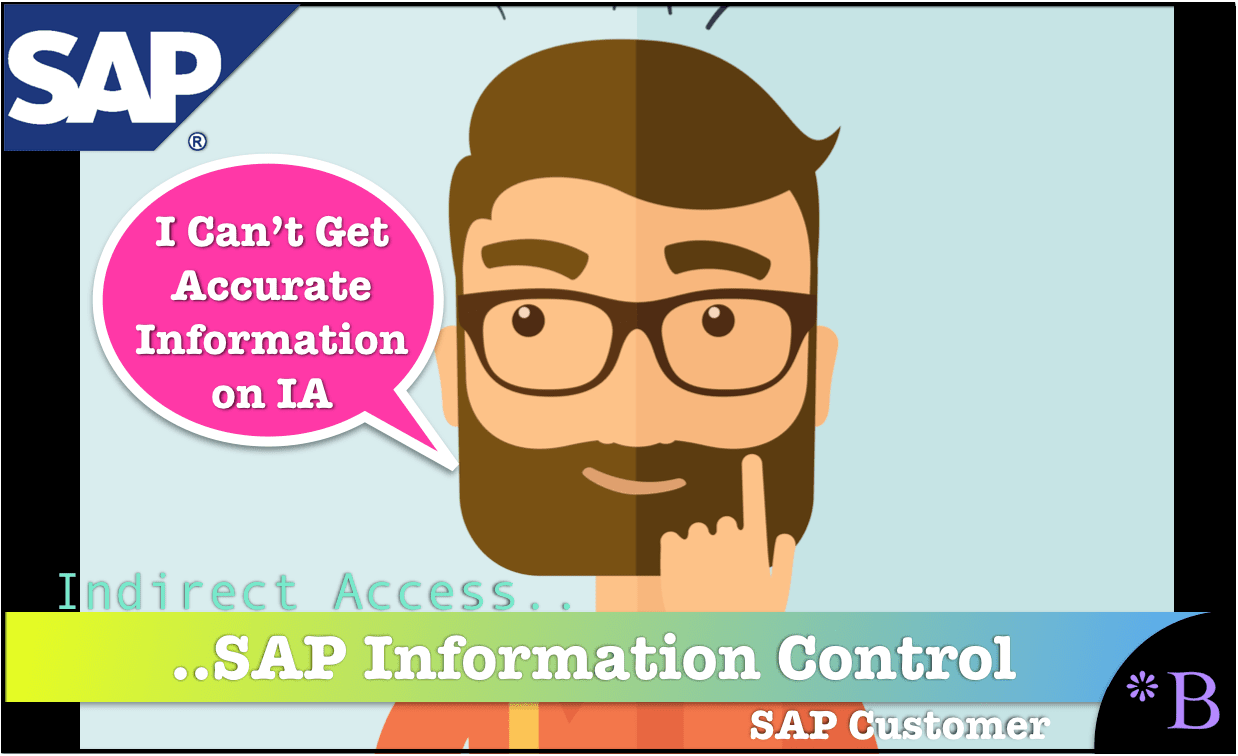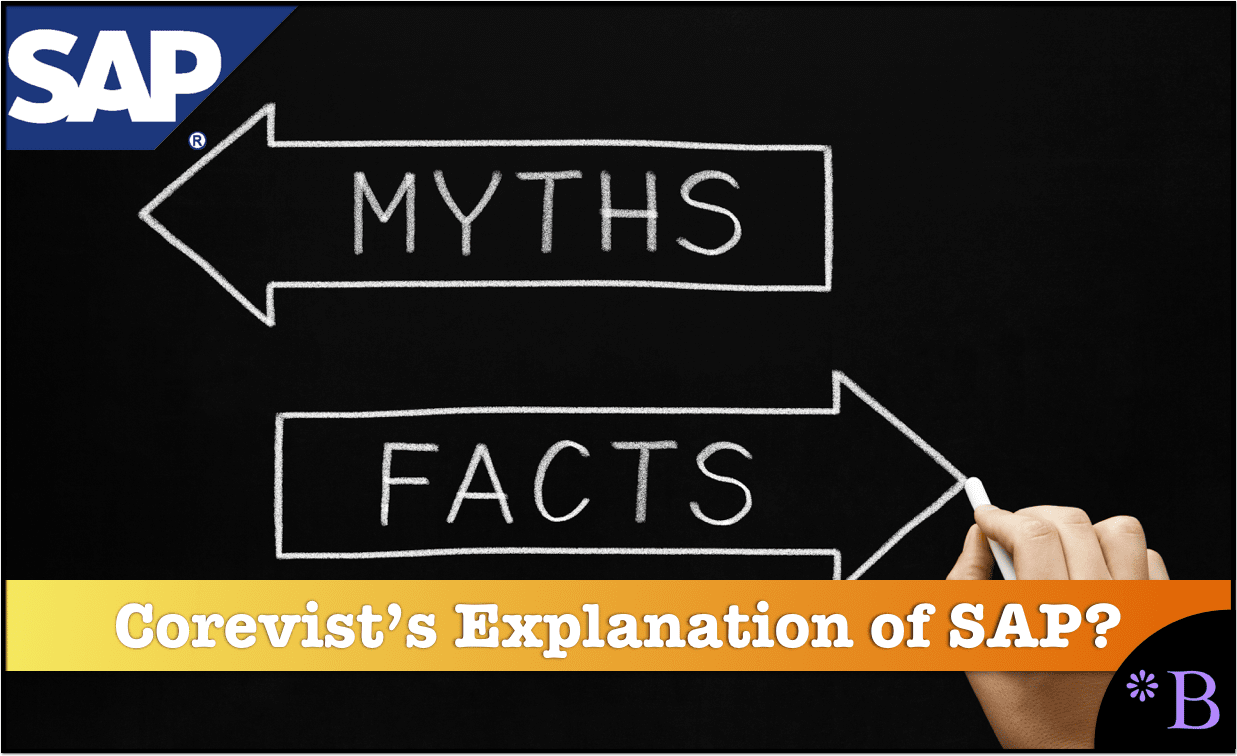The Problem with Corevist’s Presentation of SAP and Indirect Access
Executive Summary
- Corevist pointed out issues with SAP indirect access. However, as context Corevist creates a mythological idea of a glorious SAP ecosystem. In this parallel universe, SAP is new to monopolist behavior, is new to stifling competition, new to anti-trust law violations.
- What Corevist does not mention is that Corevist is restricted due to its partnership agreement as to what it can say.
*This is an in-process research design document. It will be updated as the design is refined.
Introduction
For over a year, Brightwork has been offering some of the most in-depth coverage of SAP’s indirect access application. Recently, Corevist, a software provider of cloud-based B2B, has become prominent in its criticisms of SAP’s indirect access application.
Our References for This Article
If you want to see our references for this article and other related Brightwork articles, see this link.
Notice of Lack of Financial Bias: We have no financial ties to SAP or any other entity mentioned in this article.
- This is published by a research entity, not some lowbrow entity that is part of the SAP ecosystem.
- Second, no one paid for this article to be written, and it is not pretending to inform you while being rigged to sell you software or consulting services. Unlike nearly every other article you will find from Google on this topic, it has had no input from any company's marketing or sales department. As you are reading this article, consider how rare this is. The vast majority of information on the Internet on SAP is provided by SAP, which is filled with false claims and sleazy consulting companies and SAP consultants who will tell any lie for personal benefit. Furthermore, SAP pays off all IT analysts -- who have the same concern for accuracy as SAP. Not one of these entities will disclose their pro-SAP financial bias to their readers.
Corevist’s SAP Quotes
“I love SAP. Always have, always will.
I love how SAP simplifies business, especially for midmarket firms. Where would we be without it?”
Well, IT would have a much more open environment. They would not have firms like Accenture and Deloitte ripping off customers globally using SAP as a way to do it. Other software vendors would flourish. Overall it would be a fantastic development.
What Sam is doing is presenting is the myth of the golden age of SAP.
We cover the myth of this golden age in the article The Myth of SAP’s Golden Age.
We find it strange to pledge such loyalty to something that is not the primary thing you have focused on in your career.
The Myth of the Glorious SAP Community
“I love the SAP community, and I love the people who make the B2B market tick.”
And what is the SAP community?
Do we speak of the Oracle community or the SAS community? A little perhaps but nowhere near as much as we discuss the SAP community, often described as the SAP ecosystem by Vinnie Mirchandani in his book SAP Nation.
SAP’s ecosystem is enormous and enormously powerful. I describe it like this in the intro to Brightwork’s S/4HANA Implementation Study.
“SAP leadership perceptions are the result of a global orchestrated powerful ecosystem all with vested interests. System integrators, CIOs/CFOs, analysts and IT media defend the perception of SAP leadership to preserve their interests, which have been valued in trillions of dollars. (See the book SAP Nation and SAP Nation 2.0 by Vinnie Mirchandani for a fuller explanation of the financial implications of SAP’s ecosystem.) According to Gartner, Accenture has 46,000 SAP consultants, IBM has 36,000, can you count on their neutrality to give you advice on SAP? They clone what SAP says with no research or verification, what SAP says they repeat. This leads to zero objectivity and what should, logically at least, amount to zero credibility as to the viability of S/4HANA.”
A Coalition of the Billing
It’s a coalition of companies built around making the most money as possible from a company that has a monopolistic power over its consumers. Accenture and Deloitte recommend SAP for the only reason that they can make the most money recommending SAP. Software vendors subordinate themselves to SAP’s partnership agreement, which controls these companies’ media output concerning SAP.
Does no one seem to ask why other software vendors need to be “partners” with SAP? Systems are supposed to be freely connected with other systems. But SAP does not work like that. To get into SAP accounts, other vendors often need to be “certified solutions.” This gives SAP enormous power over these vendors. Before we get to the topic of indirect access, if anti-trust laws were still enforced, there would be many questions about SAP’s partnership program. That is, does SAP abuse its power over SAP software vendor partners? And why was this arrangement created in the first place?
Media entities write SAP-friendly articles in return for cash. This is the community that Corevist defends.
But now Corevist has a complaint about this wonderous SAP community, and that is indirect access.
A Love of Intellectual Property Law?
Sam Bayer explains it like this.
“I love intellectual property laws. They protect the spirit of innovation that built our economy–the same spirit that undergirds the entire tech industry.”
Well, not entirely. This is the cover story for intellectual property laws, but the reality is a far murkier affair.
Pharmaceutical companies use intellectual property laws in the US to extend patents on drugs when they expire. Indirect access is a perfect example of a ludicrous exaggeration of intellectual property laws. SAP defines violating its IP as any company that connects to its system. So it would seem strange that Sam would take this time to laud intellectual property laws.
Furthermore, there is a large contingent of law that questions the validity of software patents. There has been the rise of unethical legal specialist firms called patent trolls. They run around looking for low-hanging fruit. That is, companies can bring suits against and shake them down for settlements. The cost of defending even a spurious patent lawsuit runs between $1.5 and $3 million. This causes most defendants to settle.
Patent Trolls as Wide Eyed “Entrepreneurs”
Most patent troll lawsuits in the US are brought in a single district in Tyler, Texas. This is done even though neither the plaintiff nor the defendant has offices there. The cases are brought there because years ago, Texas Instruments found success bringing cases in a district with a small criminal backlog. Now patent troll lawsuits are big business for Tyler, TX.
Long story short, all is not well with software intellectual property rights. One cannot declare universal love for software intellectual property rights without qualifying what parts. Furthermore, SAP has much more IP protection than other software vendors because they have so much more money for IP attorneys.
Is SAP New to Monopolistic Behavior?
“But I don’t like illegal monopolies.”
Sam makes it sound like this is something new.
SAP takes intellectual property from smaller vendors; they had a specific program for this called xApps that was partially designed to pull IP out of smaller vendors, which you can read about in our article Its Time of the xApp Program to Die. Teradata, a longtime partner of SAP, filed a lawsuit against SAP alleging (among many other things) IP theft and using monopoly power in the ERP market to coerce customers to purchase HANA instead of Teradata’s products.
138. Teradata has been harmed and will continue to suffer irreparable harm as a consequence of SAP’s conduct. Teradata is entitled to an injunction on restraining SAP from engaging in the unlawful tying of upgrades to its ERP Applications with HANA. Unless and until SAP is enjoined, SAP will continue to engage in the unlawful tying set forth above.
149. Moreover, SAP’s conduct has immediate and significant anticompetitive effects.
As set forth above, customers cannot justify paying for EDAW products with substantially overlapping functionality. As the result of this conduct, Teradata and similarly situated vendors will be forced to exit the market.
We were one of the few entities to call for it to end, which that specific program did, but in conversations with some vendors, it is widely known that SAP will reverse engineer their partners’ solutions. This has been told to customers by SAP consultants in meetings, but perversely as a positive.
How SAP Promises to Copy IP From Othe Vendors Constantly
The following quote is a paraphrase of a comment made to roughly ten people in a meeting at one of my clients. It was meant to influence the customer from selecting what was, in my view, a far better application than what SAP was offering.
“You can go with a best of breed solution, but you have to understand that SAP is constantly surveying the landscape and eventually puts anything that it sees into SAP, so eventually you get the same thing in SAP’s software anyway.”
Now that is a lovable company!
But as SAP does not have a functioning PLM, MDM, warehouse management system, and many others, while SAP does this, it is not true that SAP can pull this strategy off.
Software companies, consulting companies, media entities all line up to SAP to show their fealty because, at the end of the day, all of these companies are about profit maximization. And it is challenging to find any of them that will stand up to a multinational bully, a company utterly without honor or any ethical center.
Is SAP New to Stifling Competition and Mafia Style Sales Techniques?
“I don’t like illegal bundling of goods and services that stifles competition.
I don’t like the 800lb gorilla pushing people around, isolating them, making them feel powerless.
I don’t like Mafia-style sales techniques that force unnecessary products on customers who are scared to buy an alternative.”
Once again, this is curious to isolate this to indirect access, as it has always been how SAP operated. It just so happens that now it has reached Corevist. Corevist loses business because of SAP’s use of the false construct of Type 2 indirect access.
But let us be honest, at what point in SAP’s history did SAP not…
“use mafia style sales techniques to force unnecessary products on customers?”
Sam seems to have little experience with SAP account executives or SAP sales cycles. SAP does this all the time. In fact, in many sales competitions on SAP accounts, the demos and vendor visits are just a pantomime to create a software selection illusion. In at least 1/2 of the cases, the winner has already been decided.
Common Tactics Employed by SAP
Let us review common tactics used by SAP over the decades.
- Scaring Companies with Integration: Corevist is not aware that SAP has been using the false argument that non-SAP products are hazardous because they are so difficult to integrate into SAP to scare companies away from buying non-SAP products? And of course, who did whatever they could to make SAP’s products difficult to connect to SAP? The reader can have one guess.
- SAP Partner (Biased) Recommendations: Corevist is unaware that SAP consulting partners constantly rundown non-SAP products in a formal conspiracy with SAP? Furthermore, these tactics go back to when SAP first began developing partnerships with consulting companies in the 1980s?
Is SAP New to Stifling Innovation?
“I don’t like illegal activities that stifle innovation within the SAP community.”
SAP ranks as one of the lowest vendors in overall innovation by Brightwork.
This is covered in the article on innovation. After analyzing SAP, we gave them a score of 1 out of 10 in our Honest Vendor Ratings. SAP is one of the only vendors we have ever analyzed to be negatively innovative.
This is probably a new term for readers. So what is negative innovation?
Negative innovation is when a company takes innovations made elsewhere and makes them worse when they implement them in their software. They are the only vendor we know to create a false storyline about their co-founder inventing a new database, which we analyzed and found false in the article Did Hasso and PhDs Invent HANA?
So if you don’t like companies that stifle innovation, you won’t like SAP. But it is not merely because of indirect access. SAP has always done whatever it could to stifle innovation.
They also perpetually lie about their actual level of innovation.
Is SAP New to Antitrust Law Violations?
“I don’t like antitrust law violations, especially when they hurt my friends in the SAP community.
I don’t like SAP’s indirect access policy. Not one bit.”
As I stated, the only companies that benefit from SAP are SAP and their consulting partners. Virtually everyone else, including SAP’s customers, loses. But furthermore, and specific to Corevist’s claim, SAP has been performing activities that violate the tying agreement clause in anti-trust law for some time. Even before indirect access, SAP would bundle products in a way that gave them an unfair advantage versus competing software vendors.
And what has been the implementation history of these bundled applications?
SAP’s products outside of ERP, which tends to hold companies back, are desultory. The typical non-ERP product from SAP will fail in implementation, as is covered in the article How SAP is Now Strip Mining its Customers.
These products have lead to one of the largest wastes of IT dollars in the history of IT. It would not be easy to find a close second. And there are hundreds of thousands of people who want to see the monumental waste continue for no other reason than they can make money off of it. Deloitte, Accenture, Infosys want the status quo to continue for obvious reasons.
Is the Press Waking Up to Indirect Access?
“I’m glad that the press is finally waking up to the severity of this issue. Please read this article and pass it on.”
The press that Sam Bayer refers to is ComputerWeekly.
If you read the article, we take issue with Sam’s interpretation of the press as “waking up.” CW covered indirect access; they did little to illuminate the topic. They can’t. CW’s only real interest is in collecting email addresses and sharing that information with technology companies so they can market to prospects. CW is a honeypot used to attract contacts that it can resell to tech companies. CW sells these names to close to 1000 tech companies who are customers.
Therefore, and for obvious reasons, ComputerWeekly is extremely limited in what it can write about any one of its customers.
We covered ComputerWeekly in this article How Computer Weekly is a Front for Marketing Automation.
This is the IT media that is “waking up.”
Conclusion
Corevist appears to present indirect access as some recent change, of course, on the part of SAP. But the evidence that we have gathered through a tremendous amount of research hours is that indirect access is just another form of abuse in a long-established pattern by SAP.
Corevist has a particular strategy planned out for how to raise the issues on indirect access. This seems based upon getting coverage in the standard IT media outlets. But Corevist’s strategy is based upon a foundation that is fundamentally supportive of SAP papering over all of SAP’s previous abuses and restricting the conversation to SAP’s enforcement of indirect access.
The Limits of What Corevist Can Say and Write
When we reviewed the Corevist website, what do we find? We already thought we would find this.

What does that mean regarding Corevist’s press freedom?
Well, it means that Corevist can only push so far on indirect access and that they had better be careful not to attack SAP generally or be shown to be supportive of any entity or comments that do (like Brightwork, for instance) because SAP can pull that certification at any time.
Interestingly, we find some tie to SAP everywhere we look in the SAP community and IT media. Either its media funding or consulting revenue or, in this case, a valued SAP Certification. In interactions with both Corevist and Dennis Howlett (Howlett’s Diginomica receives funding from SAP), CW (CW is merely a front for marketing automation to roughly 1000 tech companies). We pointed out these connections. As soon as we traced these connections, we received ad hominem arguments in return.
Ad hominem arguments are a type of logical fallacy and are used as a distraction to circumvent the defendant’s argument. We are told that everyone has some bias, and therefore our evidence is not material. And who tells us this exactly? People with an undeniable financial bias or official tie to SAP.
This brings up whether Corevist can bring the full story of SAP once the topic moves outside of indirect access. Also, it needs to be remembered that Corevist is not a research entity. They sell and implement B2B software. As with most software vendors, information is released to increase revenues. They have no adherence to any particular research standard or ability to make the observations that we make.
Unfortunately, one cannot place indirect access within the proper context without having an accurate picture of SAP long-term behavior.

The Problem: Secrecy Around Indirect Access
Oracle, SAP, and their consulting partners, ASUG, and the IT media entities all have something in common. They don’t want indirect access understood. Media outlets like Diginomica are paid to distribute PR releases as articles, as we covered in the article SAP’s Recycled Indirect Access Damage Control for 2018. The intent is to lower SAP customers’ concern around indirect access so that indirect access is underestimated, as we covered in the article The Danger in Underestimating SAP Indirect Access.

The primary providers of information in the SAP space are all financially linked to SAP. SAP does not want indirect access understood, so these entities do as they are told by SAP.
